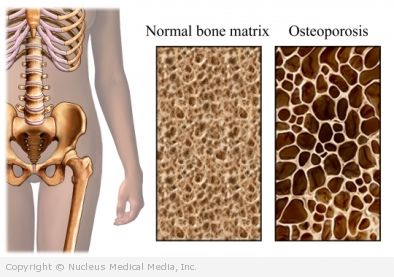Osteoporosis – Definition
Osteoporosis is when bones become weak and brittle. If left unchecked, it can lead to bone breaks ( fracture). Any bone can be affected, but of special concern are fractures of the hip, spine, and wrist.
Osteoporosis – Causes
Throughout life, old bone is removed and new bone is added to the skeleton. During childhood and adolescence, new bone is added faster than old bone is removed. As a result, bones become heavier, larger, and denser. Peak bone mass is reached at around age 30. From that point, more bone is lost than replaced. If not treated, bone losses may lead to osteoporosis. Osteoporosis is more likely to occur if full bone mass was not achieved during the bone-building years.
Bone density also plays a role in bone health. Bone density is determined by the amount of calcium, phosphorus, and other minerals within the bone framework. As the mineral content of a bone (especially calcium) decreases, the bone weakens. Getting enough calcium and vitamin D and exercising regularly can keep bones strong throughout life.
Osteoporosis – Risk Factors
There are many risk factors that may increase your chance of developing osteoporosis. Some of the risk factors include:
- Age (risk increases with age)
- Low weight
- Smoking
- Alcohol abuse
- History of falls
- Certain conditions, such as:
- Rheumatoid arthritis
- Cardiovascular disease
- Type 2 diabetes
- Asthma
- Liver disease
- Eating disorder
- Depression
- Crohn’s disease
- Use of certain medicines (eg, antidepressants, warfarin (coumadin), long-term heparin, corticosteroids, thyroid medicine, anticonvulsants, antacids)
- Low hormone levels (low estrogen levels in women, low testosterone levels in men)
- Inactive lifestyle
- Certain restrictive diets (eg, not getting enough calcium or vitamin D)
- Too little sunlight (The effect of sun on the skin is a primary source of vitamin D.)
- Cancer, including lymphoma and multiple myeloma
More women than men develop osteoporosis. Some specific risk factors that affect women include:
- Family history of osteoporosis
- Postmenopausal
- Amenorrhea (no menstrual periods)
- Gastrointestinal malabsorption
- Having another endocrine disorder (eg, thyroid disorder, diabetes)
Osteoporosis – Symptoms
Symptoms include:
- Pain when bones break or collapse
- Severe back pain with fracture of the vertebrae, wrists, hips, or other bones
- Loss of height with stooped posture (kyphosis)

Osteoporosis – Diagnosis
The doctor will ask about your symptoms and medical history, and perform a physical exam. Early signs of osteoporosis can be seen with bone density testing:
- Dual-energy x-ray absorptiometry — measures bone density in the entire body
- For older men, the American College of Physicians (ACP) recommends that your doctor check for risk factors for osteoporosis. The ACP also recommends that you have this test if you are at an increased risk and are a candidate for drug therapy. Ask your doctor about what is right for you.
- Single-energy x-ray absorptiometry — measures bone density in the arm or heel
- Dental x-rays of bone
- Ultrasound bone density measurement — measures bone density in fingers, heels, and leg bones
Other tests may include:
- Blood and urine tests —to test for calcium levels or substances created when bone is broken down
Osteoporosis – Treatment
Treatment includes:
Nutrition
Decrease your intake of caffeinated beverages and alcohol. Eat a balanced diet rich in calcium and vitamin D. Calcium is in:
- Dairy products
- Green leafy vegetables
- Canned fish with bones
- Calcium-fortified products
Smoking
Do not smoke. If you smoke, quit.
Exercise
Exercise improves bone health. It also increases muscle strength, coordination, and balance. Do weight-bearing and strength-training exercises for maximum benefit. Balance training may prevent falls and fractures.
Dietary Supplements
People who cannot eat enough calcium from food might want to take calcium supplements. Calcium citrate has the best absorption and is well-tolerated. Other vitamins and minerals may be recommended, including vitamin D, magnesium, potassium, and vitamin K. A study showed that Japanese postmenopausal women who took vitamin K supplements had a reduced rate of fractures. Talk to your doctor before taking herbs or supplements.
Medications
Your doctor may prescribe medicine to prevent bone loss, increase bone density, and reduce the risk of spine and hip fractures:
- Raloxifene (eg, Evista)
- Bisphosphonates ( alendronate [eg, Fosamax], risedronate [eg, Actonel], ibandronate [eg, Boniva], zoledromic acid [eg, Reclast])
- Calcitonin
- Fluoride
- Recombinant parathyroid hormone (eg, Teriparatide)
- Denosumab (Prolia)
Hormone Replacement Therapy (HRT)
Although HRT (including estrogen replacement therapy, or ERT) may cut the risk of osteoporosis in half, research shows a strong association between longer-term HRT or ERT use and a significantly increased risk of invasive breast cancer, strokes, heart attacks, and blood clots. Be sure to discuss all of the health risks and benefits of hormone therapy with your doctor to find out if it is right for you.
HRT therapy may include:
- Estrogen alone (ERT)
- Estrogen and progestin — frequently preferred for women with an intact uterus because ERT slightly increases the risk of uterine cancer
HRT can:
- Reduce bone loss
- Increase bone density
- Reduce the risk of hip and spinal fractures in postmenopausal women
Safety Measures
Falls can increase the chance of fracture in someone with osteoporosis. Here are ways to prevent falls:
- Use a cane or walker for stability.
- Wear rubber-soled shoes for traction.
- Use plastic or carpet runners when possible.
- Keep rooms free of clutter.
- Install grab bars in bathrooms.
Osteoporosis – Prevention
Building strong bones throughout the early years is the best defense against osteoporosis. There are four steps to prevent osteoporosis:
- A balanced diet rich in calcium and vitamin D
- Weight-bearing exercise
- Healthy lifestyle (eg, no smoking, drinking alcohol only in moderation)
- Bone density testing and medicines where appropriate:
- Fosamax
- Actonel
- Evista

